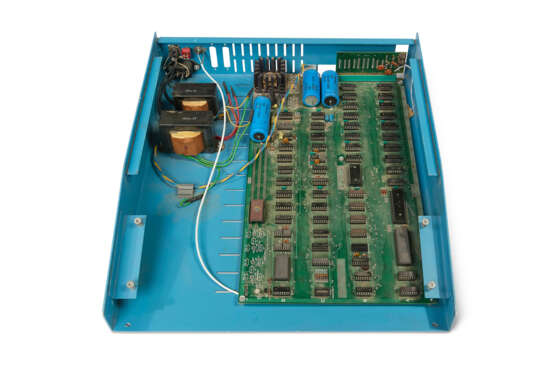ID 1279131
Лот 10 | AN APPLE-1 PERSONAL COMPUTER
Оценочная стоимость
$ 500 000 – 800 000
APPLE INC, 1976
Including an Apple-1 motherboard: labelled Apple Computer 1 Palo Alto Ca. Copyright 1976 on obverse with four rows A-D, and columns 1-18, black 6502 microprocessor, 8K bytes RAM in 16-pin 4K memory chips, original 3 “Big-Blue” power supply capacitors, firmware in PROMS (A1, A2), low-profile sockets on all integrated circuits, fitted with original Apple cassette interface card, and additional EPROM; mounted in grey painted metal casing with keyboard, and a monitor; with access badge for Don Hutmacher
From the office of Steve Jobs: the first Apple computer. A herald of the home computing revolution and of the internet age.
The Apple-1 computer is the first personal computer sold with a fully assembled motherboard. What began as the attempt by two techie friends to design and build a microprocessor became the first personal computer and launched Apple Computer. The perennially pioneering company would go on to define and redefine its industry – changing the lives of its millions of customers in the process– and ultimately become the world’s largest corporation. After introducing their new creation to a small group of like-minded friends at the Homebrew Computer Club in Palo Alto, California, Steve Jobs and Steve Wozniak were able to secure an order for 50 computers from Paul Terrell, owner of the Byte Shop, a small local retail outlet. The Apple-1 systems were sold without casing, power supply, keyboard or monitor, but the pre-assembled motherboard put Apple far ahead of its competitors.
After securing that initial order, Jobs and Wozniak scrambled to find cash for the necessary parts, selling personal property (a VW van and HP-65 calculator, respectively) to finance the operation. Working furiously from the Jobs household, spread out through the garage, living room and even a bedroom, the young men and their friends and families built the motherboards by hand to fulfil the Byte Shop order, and made an additional small quantity to be sold directly to friends and members of the Homebrew Computer Club. Approximately 200 Apple-1s were built, but under half of those still exist, as recorded in the online Apple-1 Registry.
One of the 200 was held back by the company, and had an EPROM added to reduce the time needed to load BASIC on starting it up, with the intention, probably, of its being used an demo unit. This is the only known Apple I which made use of the prototyping area. A 4K EPROM containing the Apple Monitor and Integer BASIC bypasses the original Apple I PROM monitor and is effectively the early prototype for how the Apple II computer would function. In 1985 this unique unit was removed from its place in Jobs’ office by Don Hutmacher (along with a pound of coffee), after Jobs was dismissed from Apple and engineers were allowed to take items from his office.
Hutmacher, whose security card is included in the lot, worked at Apple from 1981 to 1993, contributing significantly to the development and manufacturing of Apple products, including the Apple III, Apple IIe, and IIc. He was involved in various engineering and manufacturing roles, including managing the implementation of advanced technologies and cost reduction strategies.
Originally priced at $666.66, Steve Jobs advertised the Apple-1 as “[a] truly complete microcomputer system on a single PC board... an extremely powerful computer system that can be used for anything from developing programs to playing games or running BASIC. […] Since the Apple comes fully assembled, tested & burned-in and has a complete power supply on-board, initial set-up is essentially ‘hassle-free’ and you can be running within minutes”.
Emboldened by the success of the Apple-1, Jobs and Wozniak soon developed the far more advanced Apple-II, first sold on June 10, 1977 and which remained in production, with improvements, until 1993. Jobs and Wozniak officially discontinued the Apple-1 in October 1977, offering discounts and trade-ins to encourage all Apple-1 owners to return their machines.
The Apple-1’s legacy extends far beyond its groundbreaking design. As the first personal computer to come with a fully assembled motherboard, it marked a pivotal moment in the history of technology, laying the foundation for the home computing revolution and shaping the future of digital innovation. Its introduction not only catalyzed the success of Apple Computer but also set a new standard in the industry for user-friendly computing. The Apple-1’s pioneering role in making computers accessible and practical for everyday use ignited a wave of technological advancement that continues to resonate today.
3 ½ in. (8.9 cm.) high, 15 in. (38.1 cm.) wide, 18 in. (45.7 cm.), overall
Provenance
The company Apple II demo unit.
Removed from Steve Job’s office in 1985 by Don Hutmacher, thence by descent.
Acquired from the above by the late owner.
Further details
This lot is subject to additional disclaimers. Please carefully review Section E(2), subsection (m) “Vintage Computers and Machines”.
| Категория аукционного дома: | Все остальные типы объектов, Инструменты |
|---|
| Категория аукционного дома: | Все остальные типы объектов, Инструменты |
|---|
| Адрес торгов |
CHRISTIE'S 8 King Street, St. James's SW1Y 6QT London Великобритания | |
|---|---|---|
| Предосмотр |
| |
| Телефон | +44 (0)20 7839 9060 | |
| Комиссия | see on Website | |
| Условия использования | Условия использования |












